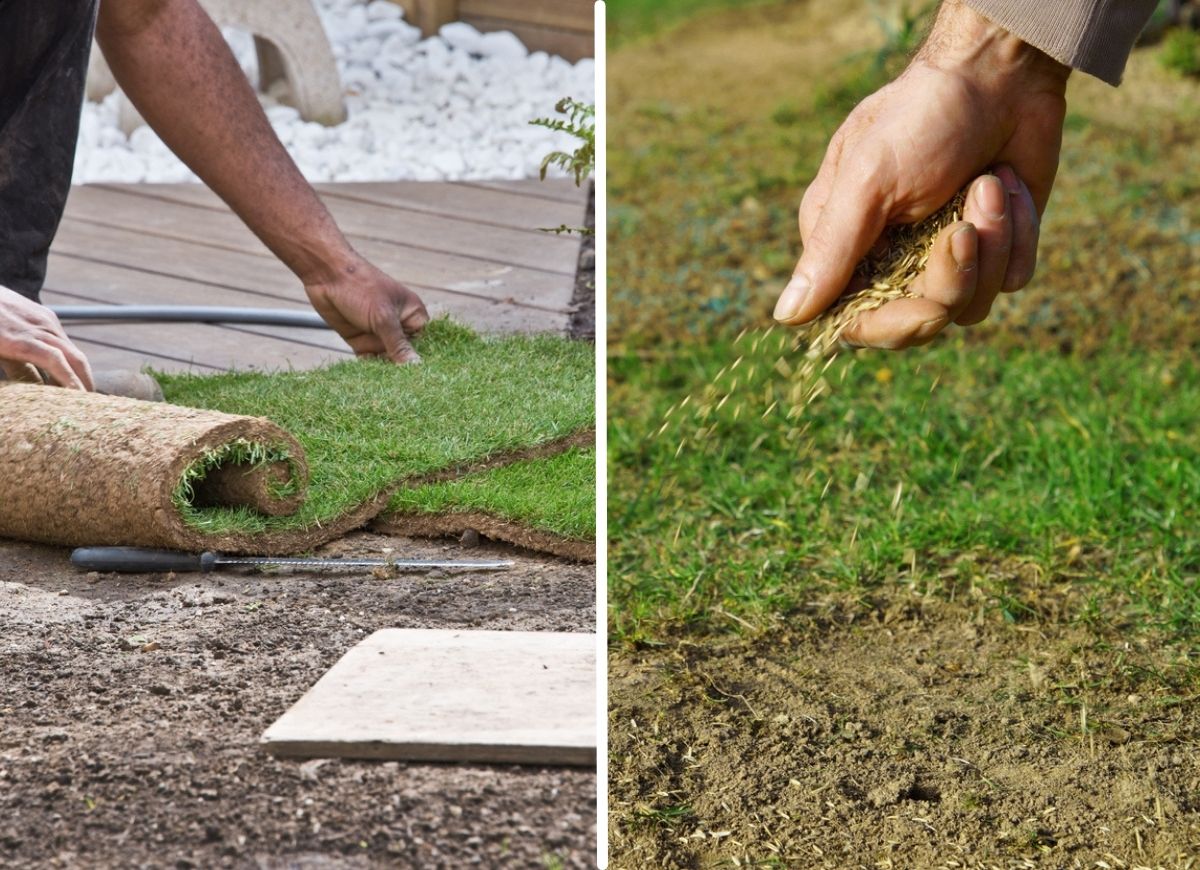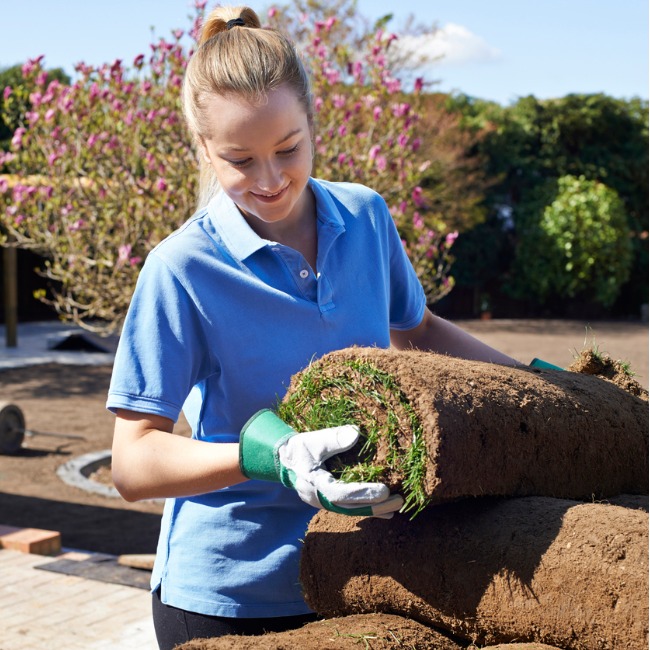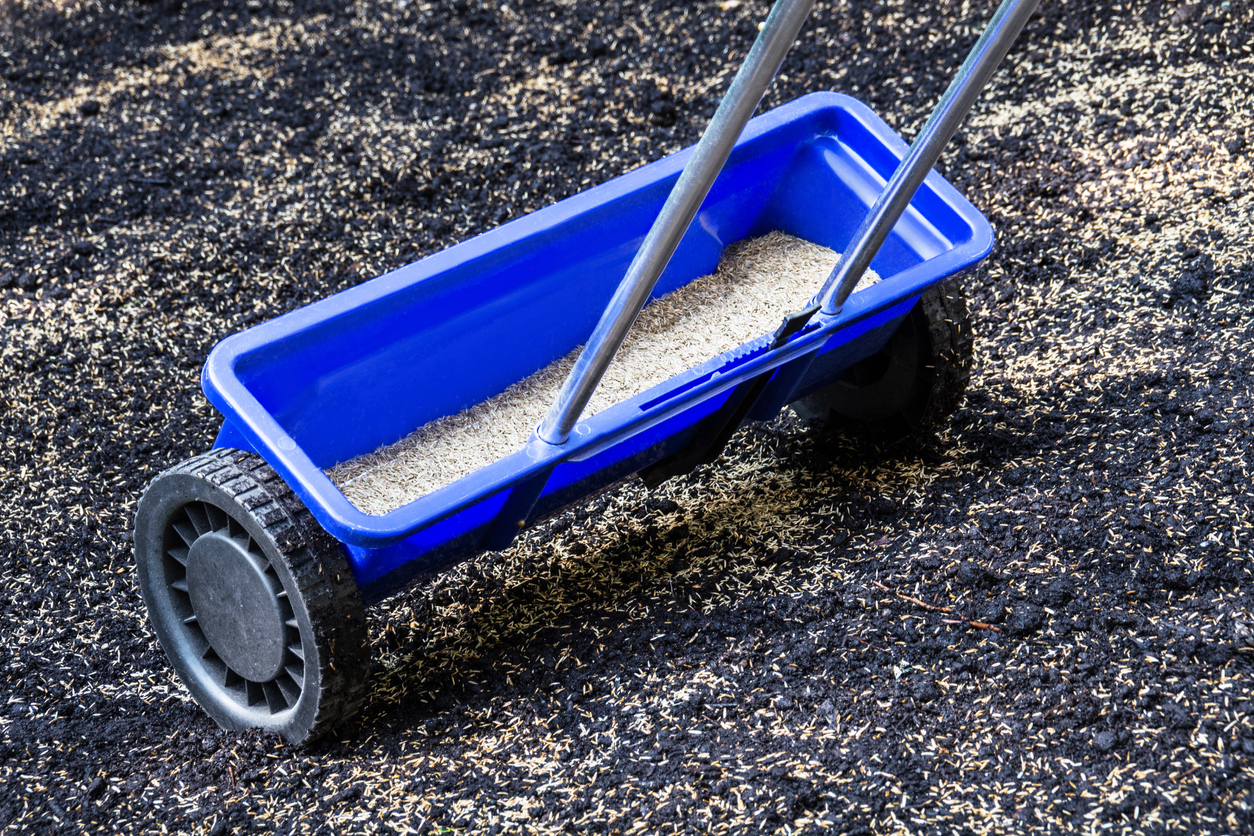

We may earn revenue from the products available on this page and participate in affiliate programs. Learn More ›
The sod versus seed debate is a conversation that homeowners have been having with their neighbors for years, as everyone has their opinions on which option is better when it comes to their lawns. However, the best way to decide between grass sod and grass seed for your own yard is to examine the benefits and drawbacks of both.
What is sod, and why would it be better than simply growing grass from seed? These are common questions that lawn care and landscaping beginners ask. Sodding essentially involves laying pre-grown rolls of grass onto soil. The rolled-up grass is sold in garden centers and can be used to quickly lay an entire lawn instead of waiting for grass seed to develop.
Read on to learn more about seed versus sod and the best way to get a lush lawn.
RELATED: How to Overseed a Lawn
Laying sod creates an instant lawn, whereas grass seed takes longer to develop.
Sod is pre-grown, so it already has roots ready to dig into fresh soil for moisture and nutrients. The grass blades are typically left long to help the sod absorb sunlight and grow quickly in their new location. Because of this ready-made nature, you can create a near-instant lawn that will become well-established in just two to three weeks with proper installation and maintenance. After the roots are established, the lawn is ready for entertaining guests or playing with kids and pets.
Grass seed can also be used to grow an entirely new lawn, but don’t expect the grass to sprout up and fill in after a few weeks. It takes at least one full growing season for a seed-grown lawn to become dense and well-established enough to withstand regular foot traffic.
Grass seed can be used to repair an existing lawn, whereas sod requires starting from bare soil.
If you don’t need to replace your entire lawn, or even a large patch of grass, then you have no need for sod. This is because laying sod requires bare soil, so you would need to cut up a significant amount of healthy grass to lay a patch of sod large enough to take root and grow.
Planting grass seed is a more effective method for repairing existing lawns, as long as you make sure to water regularly during seed establishment. When deciding whether to replace your lawn or repair it, compare the portions of dead grass and weeds to the total amount of healthy grass. If the lawn consists of more than 40 to 50 percent weeds or dead grass, then it’s better to start over with new sod. However, if approximately half or more of your lawn appears healthy, it’s likely best to plant grass seed and manually get the weeds under control.
There are more grass varieties available for seeding than sodding.

Many homeowners and DIY landscapers have a favorite variety of grass that they prefer to grow around their home. This can be based on look, feel, water needs, or rooting system, so being able to find this type of grass for lawn repairs or installation is important. However, sod isn’t always available in a wide range of varieties because it has a short 24-hour transplanting period. So if you plan to replace your existing lawn with a particular type of grass, you may be unable to find the exact one you want.
Grass seed, meanwhile, can be kept for up to three years when stored properly, so you can usually find the grass variety you want if you’re willing to wait for the seeds to grow. This broader range of choice isn’t just beneficial for personal preference, but it also allows you to use seeds designed to grow in your exact soil and weather conditions.
RELATED: 18 Easy Grass Alternatives for Your Lawn
Seeding a lawn is more DIY-friendly than sodding a lawn.
Unrolling lawn sod to quickly and effectively cover fresh soil seems much easier than seeding an entire lawn and maintaining the seeds throughout a growing season—in theory. If you don’t install sod correctly, though, it dies quickly, leaving you with less money in your wallet and an ugly, dead lawn to replace.
Determined DIYers can tackle such a landscaping project, but seeding a lawn is easier, even if it’s ultimately more time-consuming. You don’t need to worry about visible seams in your lawn or a 24-hour transplanting window when planting grass seed. Just be sure to water regularly and carefully monitor the lawn throughout the growing season. Diligent care and maintenance can lead to a lush, healthy seed-grown lawn.
Sod is better for controlling weeds and erosion compared to germinating grass seed.

Spreading seed over fresh, even soil is a great way to grow a new lawn or repair your current one, but if the location that needs fixing is near your home’s downspout, a high-traffic area, or largely comprised of weeds, then sod is a better choice. Grass seed can also be washed away by heavy rain, draining water, or even strong winds, so areas prone to erosion are also better repaired with new sod.
It’s particularly difficult for grass seed to germinate among a large concentration of weeds. It’s more likely that weeds will absorb the soil’s nutrients and moisture, preventing grass seed from growing. For better results, cut out the weed-infested lawn and replace it with sod.
A seeded lawn grows undisturbed, while sod must adapt to different growing conditions once transplanted.
Rolls of sod are cut from large grass fields on sod farms and transported to stores for sale before finally arriving at your home for installation. However, your lawn will probably have a different amount of sunlight, soil balance, and moisture content to which the new sod will need to adapt if it is to grow and thrive. Not all sod transplants are successful, especially if your lawn is very shady—new sod is typically grown in a high level of sunlight.
A lawn grown with grass seed doesn’t face the same risks, as it grows undisturbed after the initial seeding. You will need to water the seeds and monitor the lawn carefully, but the matured lawn never has to adapt to a new environment, improving the chances that the seeds will develop a deep, strong root system.
RELATED: 7 Things Your Lawn May Be Trying to Tell You
It costs more to lay sod than to plant grass seed.

A final factor to consider is price. Sod typically costs $0.60 to $1.29 per square foot, while grass seed only costs about $0.24 per square foot. This means you spend approximately $1 extra for every square foot of sod as opposed to growing a grass seed lawn. As mentioned above, if you don’t install sod correctly, there’s also a risk that the grass will simply die, leaving you with more work to remove a dead lawn.
Sod’s high initial cost and the risk that it may not root and grow properly might be a good reason to opt for sowing grass seed instead. If costs aren’t a concern, though, you can hire a professional landscaper to lay your sod and reduce the risk that the grass will die after installation.
